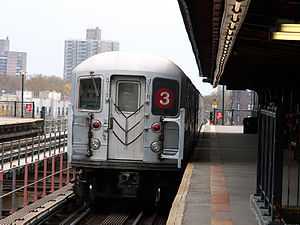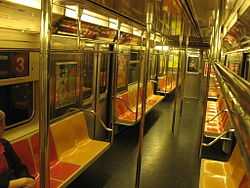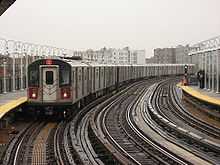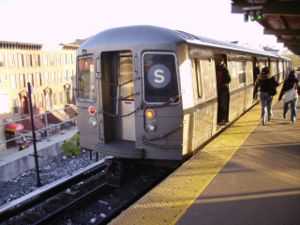R62 (New York City Subway car)
| R62 (New York City Subway car) | |
|---|---|
|
| |
|
Interior of an R62 car. | |
| In service | 1983–present |
| Manufacturer | Kawasaki Heavy Industries |
| Built at | Kobe, Japan |
| Replaced | R12, R14, R15 |
| Constructed | 1983–1985 |
| Number built | 325 |
| Number in service | 315 (260 in revenue service during rush hours) |
| Number preserved | 2 |
| Number scrapped | 8 |
| Formation | 5-car sets |
| Fleet numbers | 1301–1625 |
| Capacity |
42 (seated-A car) 44 (seated-B car) |
| Operator | New York City Subway |
| Depot(s) | 240th Street Yard, Livonia Yard[1] |
| Service(s) assigned |
|
| Specifications | |
| Car body construction | Stainless steel with fiberglass end bonnets |
| Train length | 510.4 feet (155.6 m) |
| Car length | 51.04 feet (15.56 m) |
| Width | 8.60 feet (2,621 mm) |
| Height | 11.89 feet (3,624 mm) |
| Platform height | 3.6458 ft (1.11 m) |
| Doors | 6 per car |
| Maximum speed | 55 mph (89 km/h) |
| Weight |
74,900 pounds (34,000 kg) (Odd car) 74,540 pounds (33,810 kg) (Even car) |
| Traction system |
General Electric SCM 17KG1924A1 Group as built, Currently Bombardier ECAM Groupswitch General Electric 1257E1 motors |
| Power output | 115 hp (85.8 kW) on all axles |
| Acceleration | 2.5 mph/s (4.0 km/(h·s)) |
| Electric system(s) | 625 V DC Third rail |
| Current collection method | Contact shoe |
| Braking system(s) |
WABCO RT2 Braking System WABCO Tread Brake Unit |
| Safety system(s) | emergency brakes |
| Coupling system | Westinghouse H2C |
| Track gauge | 1,435 mm (4 ft 8 1⁄2 in) standard gauge |
The R62 is a New York City Subway car built between 1983 and 1985 by Kawasaki Heavy Industries in Kobe, Japan, serving the A Division (IRT). The R62 fleet is numbered 1301–1625, totaling to a number of 325 cars. Each car was purchased at an average price of US$918,293. The R62s were used to replace the remaining R12s, R14s and R15s in service.
History
In 1980, with the bus and train fleets in poor shape, the New York City Transit Authority (NYCTA) was looking into capital maintenance and bond acts to replace its aging fleet of R12s, R14s, R15s and many R17s; and to rebuild or renovate older late 1950s and early 1960s IRT type cars. The plan called for 325 IRT cars, under the R62 contract, ordered on April 12, 1982, and awarded to Kawasaki of Japan. This was the first time a foreign company was chosen to build cars for the New York City Subway.
Delivery
The R62 was the first stainless steel and air-conditioned subway car built for the "A" Division. They continued a controversial interior design by employing bucket seating. This reduced the number of seats per car when compared to standard bench seating, but had a higher capacity for standing. This design originated with the R44, and continued with the R62A, R68 and R68A cars and R110B prototype cars. They also feature exterior speakers for the benefit of passengers on the platform. Four cars in the order (1587–90) have prototype bench seating after complaints by passengers upon delivery.[2] Bucket seating is no longer used on the newest New York City Subway cars. The R62 has full-width cabs at the end of 5-car sets and the intermediate half-width cabs have been replaced with full-width cabs.
The first set of R62s were delivered in October 1983. The cars were built as "single" units, and remained as singles until 1991, when they were linked into 5-car sets to save money and equipment. They entered a 30-day testing program on the 4 train on November 29. At that time, the new cars came as a great relief for IRT riders who were used to non-air conditioned and graffiti-filled trains. After several test runs in early 1984, the R62 cars entered regular service on the 4 train on May 7, 1984. All 325 cars were in service by August 1985, making the 4 train the first entirely graffiti-free service in the system in many years. Kawasaki did not want to build the additional cars the MTA wanted as a separate part of the R62 order, under contract R62A, for the same price. Bombardier, an Integrated Transportation rail car company headquartered in Montreal, Quebec, Canada, won a contract to supply these additional 825 cars under a license from Kawasaki. The R62s used to run on the 4 train; but they currently run on the 3 train except for 20 R62s, which are in service on the 1 train.
Replacement
Initial replacement of the R62s is scheduled for 2023 with additional replacements in 2026.[3] The MTA is proposing mid-life technological upgrades for the R62s, including LED destination signs and automated announcements.[4]
Accidents
On August 28, 1991, a sleep-deprived and intoxicated motorman crashed a southbound 4 train north of the 14th Street – Union Square station in Manhattan. The train was diverted from the express track to the local due to repairs, and the motorman sped through the switch at 40 m.p.h.; as a result, the first car made the switch while several other cars in the consist did not. Five riders were killed and several dozen were injured. Cars 1435, 1436, 1437, 1439 and 1440, were wrecked in this accident, and are now all scrapped and off MTA property. The remaining five cars of the consist (cars 1431–1434 and 1438) are now unitized, with 1438 becoming an "A" (cab) car instead of a "B" (trailer) car.[5][6]
On December 21, 1994, disgruntled computer analyst Edward J. Leary firebombed a crowded 4 train at Fulton Street. Car 1391 suffered interior damage and was repaired and returned to service. A little more than three years later, however, on February 3, 1998, cars 1391–1395, while out of service, rear-ended another out-of-service train of R33s at the 239th Street Yard. All five cars suffered anticlimber damage, but were repaired and returned to service.
On October 25, 2000, during the 2000 World Series, a rear-end collision occurred at the Fordham Road station on the IRT Jerome Avenue Line in the Bronx.[7] Car 1369 and half of car 1370 was scrapped in 2005. Car 1366 and the undamaged half of car 1370 are at the FDNY Randall's Island training center. Cars 1367 and 1368 were reefed in February 2008.[8]
See also
- R62A (New York City Subway car) – a similar model built by Bombardier Transportation Corp.
References
- ↑ New York Subway Barn Assignments
. December 2014 - ↑
- ↑ MTA Capital Program Oversight Committee Hearing, June 2010 (page 20)
- ↑ Request For Information No. 9003 | Integrated Communications System on NYCT R62/R62A and R68/R68A Class Rail Cars
- ↑ http://www.nysubway.com/safety/subwaysafety.html
- ↑ 44:10-50:10 in this video do a small documentary on the accident: http://www.youtube.com/watch?v=2KKVupF7Uug
- ↑ ORIGINAL KODACHROME SLIDE R-62 #1369 DEMOLISHED AT CONCOURSE YARD NOV 3, 2000\
- ↑ http://www.nytimes.com/2008/04/08/us/08reef.html
Further reading
- Sansone, Gene. Evolution of New York City subways: An illustrated history of New York City's transit cars, 1867–1997. New York Transit Museum Press, New York, 1997 ISBN 978-0-9637492-8-4
External links
| Wikimedia Commons has media related to R62 (New York City Subway car). |
- nycsubway.org—NYC Subway Cars: R62/R62A
- Car Status/Assignment
- IRT Car Assignments - June 16, 2014
- New York City Subway Car Fleet June 2010 through June 2014
| |||||||||||||||||||||||||||||||||||||||||||||||||||||||||||




